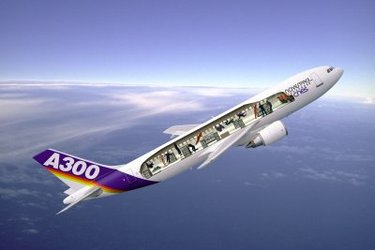35th ESA Parabolic Flight Campaign Day One: foggy take-off, sunny finish
It took longer than usual for the 'Zero-G' A-300 Airbus to leave gravity behind on Tuesday, the first day of ESA's 35th Parabolic Flight Campaign. With Bordeaux and surrounding French countryside mired in fog it wasn't until 13:55 CEST that the aircraft finally soared into a grey sky.
Eager experimenters had been waiting since 08:00 for the plane to take off, their transport to weightless conditions. However, the A-300 couldn't begin its 31-parabola flight above the Atlantic until all its network of back-up airports were clear for landing, down from Brest to Toulouse.
Clearance followed after mid-day, and medication was issued to passengers at 13:00.
Vladimir Pletser, ESA Parabolic Flight Campaign Co-ordinator, has never taken any anti-sickness drug before flying, despite being a parabolic veteran. On Monday he received a silver Novespace medal for chalking up 1284 parabolas on board the A-300.
"But with previous flights on other parabolic aircraft like the KC-135 and Caravalle, I have a lot more," Pletser explains. "In fact, during this week I will experience my 3600th parabola. I never needed any medicine, but some people get sick and some people don't – we can't predict it in advance. It's like being born with brown or blue eyes."
That sickly feeling
Just as some astronauts get sick in orbit, nausea can be induced as the local gravity effectively doubles, and then shrinks down to nothing. It is caused by a mismatch experienced between what the eyes see and what our twin balance organs report.
These organs are called the vestibular apparatus, found in the inner ear on each side of the head. They are jelly- and-fluid-filled spaces that work like combined spirit levels and accelerometers: tiny hairs called cilia record movements, detecting changes in head angle and angular velocity. Having painstakingly evolved over millions of years in the 1G environment, the vestibular apparatus finds it tough to cope with weightlessness.

Normally the vestibular apparatus coordinates with eye movement to maintain a continuous image of the world. As you move your head around, the computer screen you are reading seems to stay in the same place. However, in space, astronauts report that when they move it seems as though the world is moving rather than them. This suggests the normal connection between eyes and vestibular apparatus has been disrupted.
One experiment on this week's Campaign is investigating this relationship in more detail by seeing how the eye movement of subjects alter as gravity shifts.
"We can't see into the vestibular apparatus, but by studying eye movement, we get an insight into it – the two are closely linked," says Dr Kari Helling of the Free University of Berlin, Germany. "Our experiment is set up so our subject either keeps their head still to look at a moving object, or move their head to look at a still object. And better understanding of the underlying way the ocular-vestibular link works will help improve treatments for balance disorders suffered by many people."
Touchdown
However delayed its take-off may have been, the A-300 touched down as expected, at 16:45 CEST. Hardly any of the disembarking passengers looked in particular discomfort, although a large black plastic bag carried solemnly off the aircraft showed there had definitely been some parabolic casualties.
At the post-flight briefing, the experiment teams were generally satisfied, with only a few equipment and computer problems. The foam property experiment of the University of Paris Sud had leaked a little towards the flight's end.

At one point during the flight, ESA astronaut Philippe Perrin took some time off co-piloting the A-300 to assess the Flywheel Resistive Exercise Device in weightless conditions. Based on the same principle as a yo-yo, the exercise machine enables astronauts to simulate high-load weight training in weightlessness, working against their own energy stored in the inertia of the spinning flywheel.
High-load training helps minimise muscle and bone loss in long-term spaceflight, and the Flywheel Device is already planned for deployment on board ISS.
As the post-flight briefing came to an end, the sun came out briefly before setting. At the end of a long day the experiment teams got busy to ready their equipment for tomorrow. The weather reports indicated the flight would go ahead right on time on Wednesday.















 Germany
Germany
 Austria
Austria
 Belgium
Belgium
 Denmark
Denmark
 Spain
Spain
 Estonia
Estonia
 Finland
Finland
 France
France
 Greece
Greece
 Hungary
Hungary
 Ireland
Ireland
 Italy
Italy
 Luxembourg
Luxembourg
 Norway
Norway
 The Netherlands
The Netherlands
 Poland
Poland
 Portugal
Portugal
 Czechia
Czechia
 Romania
Romania
 United Kingdom
United Kingdom
 Slovenia
Slovenia
 Sweden
Sweden
 Switzerland
Switzerland




























